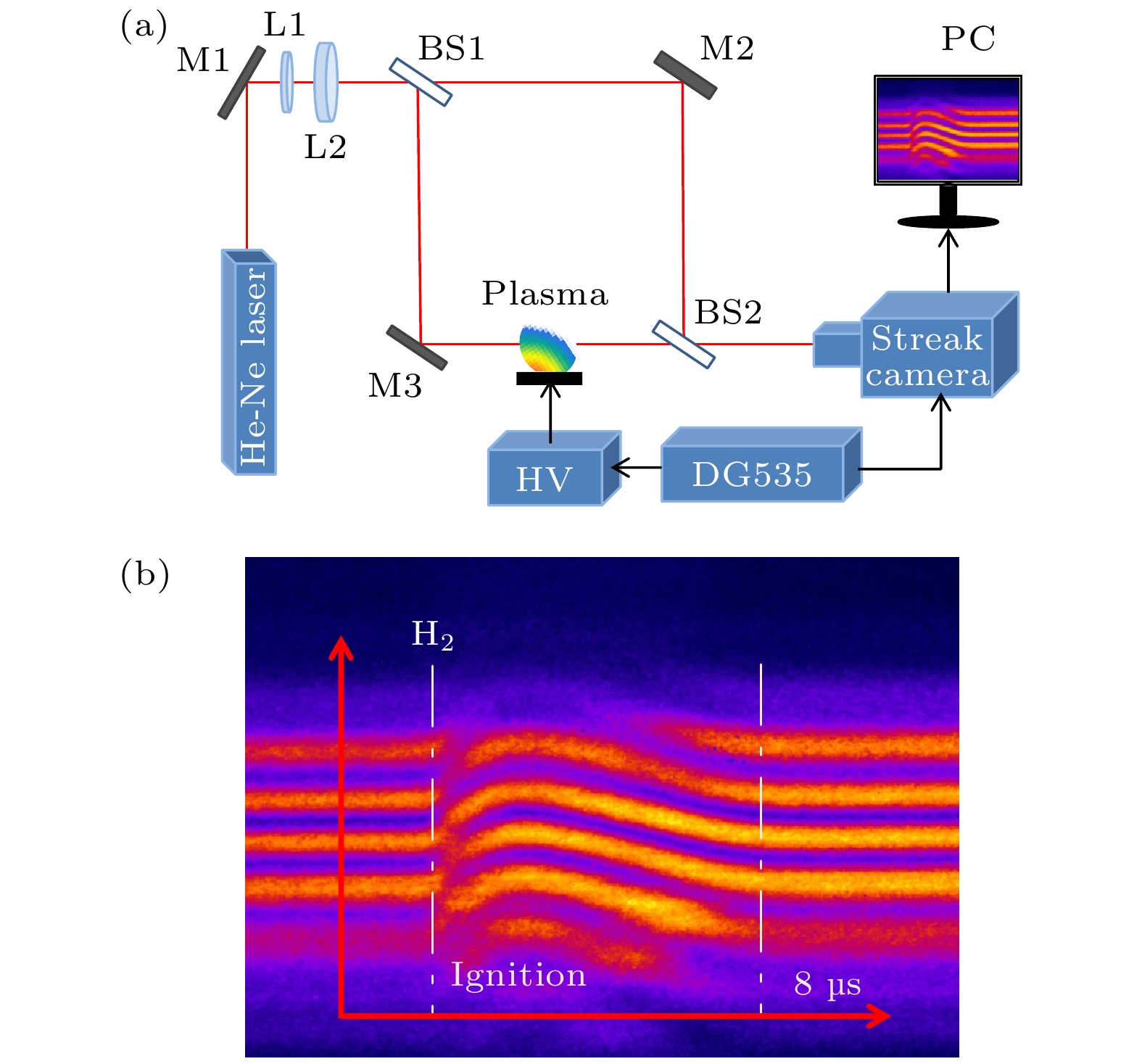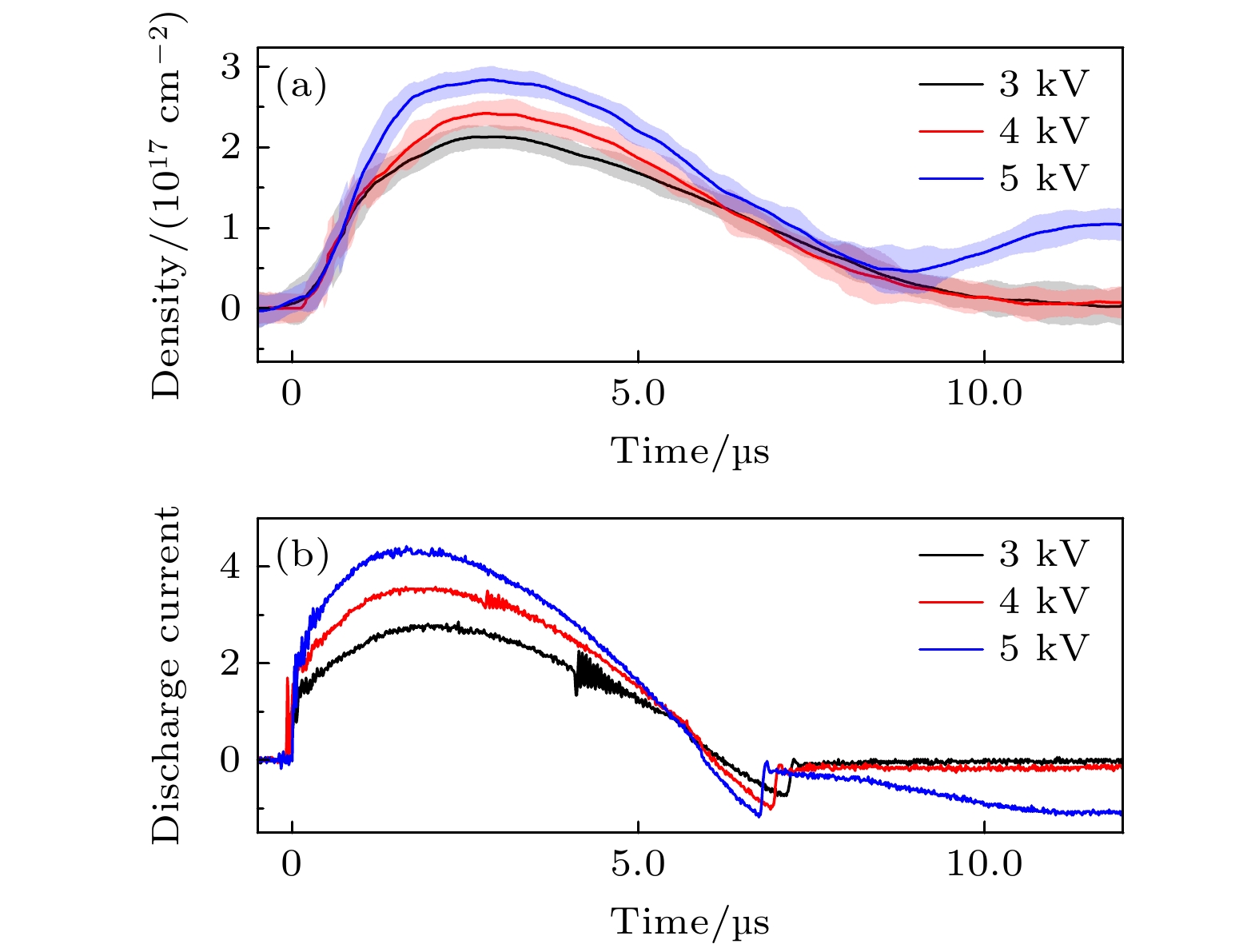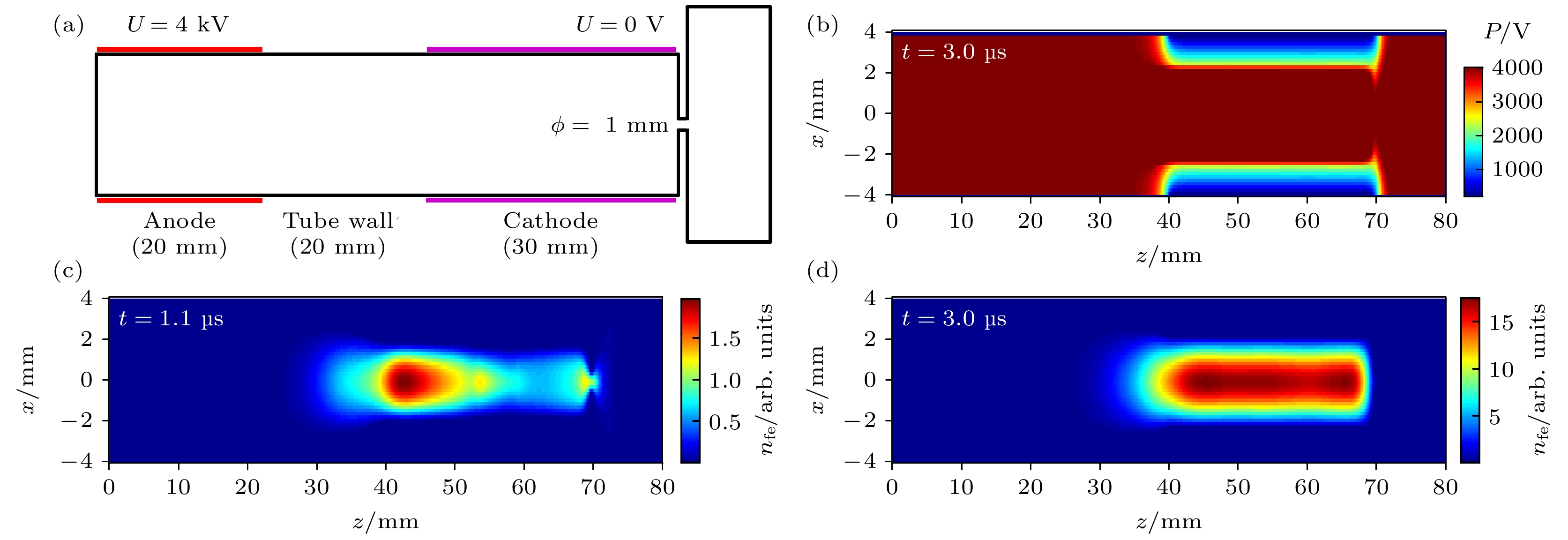-
部分电离等离子体是惯性约束聚变燃料及天体等离子体中的重要组成部分, 该等离子体的输运及流体力学等性质受到束缚电子的显著影响, 然而当前基于光谱学的技术手段难以对其进行高精度诊断. 本文基于中国科学院近代物理研究所低能离子束与等离子体相互作用实验平台, 精确测量了100 keV质子束穿过部分电离氢等离子体靶后的能损, 该能损是质子同靶区内自由电子与束缚电子碰撞共同作用的结果. 利用已有的能损理论模型, 结合激光干涉诊断获得的自由电子密度信息, 最终得到了部分电离氢等离子体靶中沿离子路径上的束缚电子密度, 并给出了该等离子体的离化度参数. 该离子束诊断技术具有在线、原位、分辨率高等优势, 为解决部分电离等离子体内部束缚电子密度的诊断问题提供了新的途径.Partially ionized plasma contains the bound electrons, which have an effect on the instability of the plasma. The evolution process of bound electron density cannot be obtained by using the existing optical method used for diagnosing the free electron density. In this work, we carry out a high-precision experiment: the energy loss of a 100 keV proton beam penetrating through the partially ionized hydrogen plasma target is measured on the platform of ion beam-plasma interaction at the Institute of Modern Physics, Chinese Academy of Sciences. The bound electron density is obtained according to the energy loss model of Bethe theory. The free electron density is measured by laser interferometry and the electron tempercture is obtained from the measured spectrum (Te = 0.68 eV; nfe = 2.41×1017 cm–2). It is found that the bound electron density decreases during plasma lifetime. The diagnosis of bound electron density by measuring energy loss of ion beam has the advantages of on-line, in-situ and high resolution, thus providing a new way to solve the problem about measuring the bound electron density in partially ionized plasma. A COMSOL simulation reveals that the high-temperature free electrons will be ejected quickly out of the plasma area through a mechanical diaphragm, thus reducing the total number of free electrons. In order to maintain a relatively high degree of ionization in this plasma, in principle, more and more bound electrons are ionized into free electrons, the density of bound electrons decreases correspondingly. The simulation result accords well with our experimental data. Based on this finding, more detailed plasma target parameter is obtained, which is helpful in deepening the understanding of the interaction process between ion beam and plasma. In future, more researches of low low-energy highly-charged ions-plasma interaction will be conducted.
-
Keywords:
- bound electron density /
- energy loss of proton beam /
- free electron density /
- ionization degree.
[1] Peacock N J, Robinson D C, Forrest M J, Wilcock P D, Sannikov V V 1969 Nature 224 488
 Google Scholar
Google Scholar
[2] Sun D X, Su M G, Dong C Z 2013 Eur. Phys. J. Appl. Phys. 61 30802
 Google Scholar
Google Scholar
[3] David C, Avizonis P, Weichel H, Pyatt K 1996 IEEE J. Quant. Elect. 2 493
 Google Scholar
Google Scholar
[4] Weber B, Fulghum S 1997 Rev. Sci. Instrum. 68 1227
 Google Scholar
Google Scholar
[5] Rocca J J, Hammarsten E C, Jankowska E 2003 Phys. Plas. 10 2031
 Google Scholar
Google Scholar
[6] José L B, Igor A, Manuel C, Turlough D, Robert F P, Holly G, Maxim K, Elena K, Ildar F S, Roberto S, Enrique V S, Teimuraz Z 2018 Space. Sci. Rev. 214 58
 Google Scholar
Google Scholar
[7] Cao S Q, Su M G, Sun D X, Min Q, Dong C Z 2016 Chin. Phys. Lett. 33 045201
 Google Scholar
Google Scholar
[8] Tan W Q, Liu Y Y, Li X Y, Yuan P, Zhao H, Li Z C, Zheng J 2021 J. Appl. Phys. 129 043302
 Google Scholar
Google Scholar
[9] Zhang S, Chen C, Lan T, Ding W X, Zhuang G, Mao W Z, Lan S J, Wu J, Xu H Q, Deng T J, Zhu J F, Wu J R, Zu Y M, Kong D F, Zhang S B, Yao Y, Wei Z A, Liu Z X, Zhou H Y, Wang H, Wen X H, Liu A, Xie J L, Li H, Xiao C J, Liu W D 2020 Rev. Sci. Instrum. 91 063501
 Google Scholar
Google Scholar
[10] Xu G, Barriga-Carrasco M D, Blazevic A, Borovkov B, Casas D, Cistakov K, Gavrilin R, Iberler M, Jacoby J, Loisch G, Morales R, Mäder R, Qin S X, Rienecker T, Rosmej O, Savin S, Schönlein A, Weyrich K, Wiechula J, Wieser J, Xiao G Q, Zhao Y T 2017 Phys. Rev. Lett. 119 204801
 Google Scholar
Google Scholar
[11] Bethe H 1930 Annalen Phys. (Leipzig) 397 325
 Google Scholar
Google Scholar
[12] Cheng R, Zhou X M, Wang Y Y, Lei Y, Chen Y H, Ma X W, Xiao G Q, Zhao Y T, Ren J R, Huo D 2018 Laser Part. Beams 36 98
 Google Scholar
Google Scholar
[13] 史路林, 程锐, 王昭, 曹世权, 杨杰, 周泽贤, 陈燕红, 王国东, 惠得轩, 金雪剑, 吴晓霞, 雷瑜, 王瑜玉, 苏茂根 2023 72 133401
 Google Scholar
Google Scholar
Shi L L, Cheng R, Wang Z, Cao S Q, Yang J, Zhou Z X, Chen Y H, Wang G D, Hui D X, Jin X J, Wu X X, Lei Y, Wang Y Y, Su M G 2023 Acta Phys. Sin. 72 133401
 Google Scholar
Google Scholar
[14] 王国东, 程锐, 王昭, 周泽贤, 骆夏辉, 史路林, 陈燕红, 雷瑜, 王瑜玉, 杨杰 2023 72 043401
 Google Scholar
Google Scholar
Wang G D, Cheng R, Wang Z, Zhou Z X, Luo X H, Shi L L, Chen Y H, Lei Y, Wang Y Y, Yang J 2023 Acta Phys. Sin. 72 043401
 Google Scholar
Google Scholar
[15] Zhao Y T, Zhang Y N, Cheng R, He B, Liu C L, Zhou X M, Lei Y, Wang Y Y, Ren J R, Wang X, Chen Y H, Xiao G Q, Savin S M, Gavrilin R, Golubev A A, Hoffmann H H 2021 Phys. Rev. Lett. 126 115001
 Google Scholar
Google Scholar
[16] 骆夏晖, 程锐, 王国东, 周泽贤, 王昭, 杨杰 2022 原子核物理评论 39 490
 Google Scholar
Google Scholar
Luo X H, Cheng R, Wang G D, Zhou Z X, Wang Z, Yang J 2022 Nucl. Phys. Rev. 39 490
 Google Scholar
Google Scholar
[17] Kuznetsov A P, Byalkovskii O A, Gavrilin R O, Golubev A A, Gubskii K L, Rudskoi I V, Savin S M, Turtikov V I, Khudomyasov A V 2013 Plasma Phys. Rep. 39 248
 Google Scholar
Google Scholar
[18] Cheng R, Zhao Y T, Zhou X M, Li Y F, Wang Y Y, Lei Y, Sun Y B, Wang X, Yu Y, Ren J R, Liu S D, Xiao G Q, Hoffmann D H H 2013 Phys. Scr. T156 014074
 Google Scholar
Google Scholar
[19] Kuznetsov A P, Golubev A A, Kozin G I, Mutin T Y, Savelov A S, Fertman A D 2006 Instrum. Exp. Tech. 49 247
 Google Scholar
Google Scholar
[20] Zhang H C, Lu J, Shen Z H, Ni X W 2009 Opt. Commun. 282 1720
 Google Scholar
Google Scholar
[21] Hanif M, Salik M 2014 J. Russ. Laser Res. 35 230
 Google Scholar
Google Scholar
[22] Griem H R 1997 Principles of Plasma Spectroscopy (Cambridge: Cambridge University Press) p281
[23] NIST Atomic Spectra Database, Kramida A, Ralchenko Y, Reader J, NIST ASD Team https://physics.nist.gov/asd [2023-8-17]
[24] Chandrasekhar S 1943 Rev. Mod. Phys. 15 1
 Google Scholar
Google Scholar
[25] Zhang Y N, Liu C L, Cheng R, Zhao Y T, He B 2020 Phys. Plas. 27 093107
 Google Scholar
Google Scholar
[26] Kreussler S, Varelas C, Brandt W 1981 Phys. Rev. B 23 82
 Google Scholar
Google Scholar
[27] Gus’kov S Y, Zmitrenko N V, Il’in D V, Levkovskii A A, Rozanov V B, Sherman V E 2009 Laser Plas. 35 771
 Google Scholar
Google Scholar
[28] Lei Y, Cheng R, Zhao Y T, Zhou X M, Wang Y Y, Chen Y H, Wang Z, Yang J, Ma X W 2021 Laser Part. Beams 2021 e15
 Google Scholar
Google Scholar
[29] McKenna K F, York T M 1977 Phys. Fluids 20 1556
 Google Scholar
Google Scholar
[30] Commisso R J, Bartsch R R, Ekdahl C A, Freese K B, McKenna K F, Guthrie Miller, Siemon R E 1981 Phys. Fluids 24 1919
 Google Scholar
Google Scholar
[31] Schneider W 1972 Zeitschrift Phys. 252 147
 Google Scholar
Google Scholar
-
图 3 (a)激光干涉成像设备示意图(M1, M2, M3为反射镜, BS1, BS2为半透半反镜, L1, L2为凸透镜); (b)氢气放电等离子体(P = 1.03 mbar, HV = 4 kV)的干涉条纹随时间的演化图像
Fig. 3. (a) Structure diagram of laser interference imaging equipment (M1, M2, M3 are reflectors, BS1, BS2 are semi-transparent and semi-reflective mirrors, L1, L2 are convex lenses); (b) evolution of interference fringes (P = 1.03 mbar, HV = 4 kV) over hydrogen plasma lifetime.
图 7 (a) 100 keV质子束与部分电离氢等离子体靶(1.03 mbar, 4 kV)相互作用后的能量损失(■为实验点, ▲与 — 分别为Bethe计算的束缚电子与自由电子部分能损数值); (b)氢等离子体中的电子密度; (c)电离度随时间的变化
Fig. 7. (a) Evolution of energy loss of 100 keV H+ ion in the plasma (1.03 mbar, 4 kV) during plasma lifetime (■ is the experimental point of energy loss of H+, ▲与 — is the energy loss contributed by bound electron density and free electron density calculated by Bethe theory, respectively); (b) change of electron density; (c) ionization degree with time.
图 8 (a)气体放电靶的二维模型中阳极(20 mm)和阴极区域(30 mm)区域; (b) t = 3 μs时放电过程中电势分布; (c), (d)等离子体中自由电子密度分别在t = 1.1, 3 μs时的分布
Fig. 8. (a) Two-dimensional model with anode (20 mm), tube wall (20 mm) and cathode (30 mm) regions of cavity; (b) potential distribution during discharge at t = 3 μs; (c), (d) free electron density of plasma in the t = 1.1, 3 μs.
-
[1] Peacock N J, Robinson D C, Forrest M J, Wilcock P D, Sannikov V V 1969 Nature 224 488
 Google Scholar
Google Scholar
[2] Sun D X, Su M G, Dong C Z 2013 Eur. Phys. J. Appl. Phys. 61 30802
 Google Scholar
Google Scholar
[3] David C, Avizonis P, Weichel H, Pyatt K 1996 IEEE J. Quant. Elect. 2 493
 Google Scholar
Google Scholar
[4] Weber B, Fulghum S 1997 Rev. Sci. Instrum. 68 1227
 Google Scholar
Google Scholar
[5] Rocca J J, Hammarsten E C, Jankowska E 2003 Phys. Plas. 10 2031
 Google Scholar
Google Scholar
[6] José L B, Igor A, Manuel C, Turlough D, Robert F P, Holly G, Maxim K, Elena K, Ildar F S, Roberto S, Enrique V S, Teimuraz Z 2018 Space. Sci. Rev. 214 58
 Google Scholar
Google Scholar
[7] Cao S Q, Su M G, Sun D X, Min Q, Dong C Z 2016 Chin. Phys. Lett. 33 045201
 Google Scholar
Google Scholar
[8] Tan W Q, Liu Y Y, Li X Y, Yuan P, Zhao H, Li Z C, Zheng J 2021 J. Appl. Phys. 129 043302
 Google Scholar
Google Scholar
[9] Zhang S, Chen C, Lan T, Ding W X, Zhuang G, Mao W Z, Lan S J, Wu J, Xu H Q, Deng T J, Zhu J F, Wu J R, Zu Y M, Kong D F, Zhang S B, Yao Y, Wei Z A, Liu Z X, Zhou H Y, Wang H, Wen X H, Liu A, Xie J L, Li H, Xiao C J, Liu W D 2020 Rev. Sci. Instrum. 91 063501
 Google Scholar
Google Scholar
[10] Xu G, Barriga-Carrasco M D, Blazevic A, Borovkov B, Casas D, Cistakov K, Gavrilin R, Iberler M, Jacoby J, Loisch G, Morales R, Mäder R, Qin S X, Rienecker T, Rosmej O, Savin S, Schönlein A, Weyrich K, Wiechula J, Wieser J, Xiao G Q, Zhao Y T 2017 Phys. Rev. Lett. 119 204801
 Google Scholar
Google Scholar
[11] Bethe H 1930 Annalen Phys. (Leipzig) 397 325
 Google Scholar
Google Scholar
[12] Cheng R, Zhou X M, Wang Y Y, Lei Y, Chen Y H, Ma X W, Xiao G Q, Zhao Y T, Ren J R, Huo D 2018 Laser Part. Beams 36 98
 Google Scholar
Google Scholar
[13] 史路林, 程锐, 王昭, 曹世权, 杨杰, 周泽贤, 陈燕红, 王国东, 惠得轩, 金雪剑, 吴晓霞, 雷瑜, 王瑜玉, 苏茂根 2023 72 133401
 Google Scholar
Google Scholar
Shi L L, Cheng R, Wang Z, Cao S Q, Yang J, Zhou Z X, Chen Y H, Wang G D, Hui D X, Jin X J, Wu X X, Lei Y, Wang Y Y, Su M G 2023 Acta Phys. Sin. 72 133401
 Google Scholar
Google Scholar
[14] 王国东, 程锐, 王昭, 周泽贤, 骆夏辉, 史路林, 陈燕红, 雷瑜, 王瑜玉, 杨杰 2023 72 043401
 Google Scholar
Google Scholar
Wang G D, Cheng R, Wang Z, Zhou Z X, Luo X H, Shi L L, Chen Y H, Lei Y, Wang Y Y, Yang J 2023 Acta Phys. Sin. 72 043401
 Google Scholar
Google Scholar
[15] Zhao Y T, Zhang Y N, Cheng R, He B, Liu C L, Zhou X M, Lei Y, Wang Y Y, Ren J R, Wang X, Chen Y H, Xiao G Q, Savin S M, Gavrilin R, Golubev A A, Hoffmann H H 2021 Phys. Rev. Lett. 126 115001
 Google Scholar
Google Scholar
[16] 骆夏晖, 程锐, 王国东, 周泽贤, 王昭, 杨杰 2022 原子核物理评论 39 490
 Google Scholar
Google Scholar
Luo X H, Cheng R, Wang G D, Zhou Z X, Wang Z, Yang J 2022 Nucl. Phys. Rev. 39 490
 Google Scholar
Google Scholar
[17] Kuznetsov A P, Byalkovskii O A, Gavrilin R O, Golubev A A, Gubskii K L, Rudskoi I V, Savin S M, Turtikov V I, Khudomyasov A V 2013 Plasma Phys. Rep. 39 248
 Google Scholar
Google Scholar
[18] Cheng R, Zhao Y T, Zhou X M, Li Y F, Wang Y Y, Lei Y, Sun Y B, Wang X, Yu Y, Ren J R, Liu S D, Xiao G Q, Hoffmann D H H 2013 Phys. Scr. T156 014074
 Google Scholar
Google Scholar
[19] Kuznetsov A P, Golubev A A, Kozin G I, Mutin T Y, Savelov A S, Fertman A D 2006 Instrum. Exp. Tech. 49 247
 Google Scholar
Google Scholar
[20] Zhang H C, Lu J, Shen Z H, Ni X W 2009 Opt. Commun. 282 1720
 Google Scholar
Google Scholar
[21] Hanif M, Salik M 2014 J. Russ. Laser Res. 35 230
 Google Scholar
Google Scholar
[22] Griem H R 1997 Principles of Plasma Spectroscopy (Cambridge: Cambridge University Press) p281
[23] NIST Atomic Spectra Database, Kramida A, Ralchenko Y, Reader J, NIST ASD Team https://physics.nist.gov/asd [2023-8-17]
[24] Chandrasekhar S 1943 Rev. Mod. Phys. 15 1
 Google Scholar
Google Scholar
[25] Zhang Y N, Liu C L, Cheng R, Zhao Y T, He B 2020 Phys. Plas. 27 093107
 Google Scholar
Google Scholar
[26] Kreussler S, Varelas C, Brandt W 1981 Phys. Rev. B 23 82
 Google Scholar
Google Scholar
[27] Gus’kov S Y, Zmitrenko N V, Il’in D V, Levkovskii A A, Rozanov V B, Sherman V E 2009 Laser Plas. 35 771
 Google Scholar
Google Scholar
[28] Lei Y, Cheng R, Zhao Y T, Zhou X M, Wang Y Y, Chen Y H, Wang Z, Yang J, Ma X W 2021 Laser Part. Beams 2021 e15
 Google Scholar
Google Scholar
[29] McKenna K F, York T M 1977 Phys. Fluids 20 1556
 Google Scholar
Google Scholar
[30] Commisso R J, Bartsch R R, Ekdahl C A, Freese K B, McKenna K F, Guthrie Miller, Siemon R E 1981 Phys. Fluids 24 1919
 Google Scholar
Google Scholar
[31] Schneider W 1972 Zeitschrift Phys. 252 147
 Google Scholar
Google Scholar
计量
- 文章访问数: 4452
- PDF下载量: 93
- 被引次数: 0














 下载:
下载:







